Breaking news
DEFEA 2023: US Army showcases advanced weapons systems and combat vehicles.
During the three days of DEFEA 2023 a defense exhibition in Greece, the U.S. Army showcased a wide array of combat vehicles, artillery systems, and advanced weaponry currently deployed by the Ukrainian forces in their ongoing conflict with Russia. The U.S. Army's presence at the International Defense and Security Exhibition highlighted the high-tech arsenal that has seen action not only in Ukraine but in various global theatres, with some units also being considered by the Greek Armed Forces.
Follow Army Recognition on Google News at this link
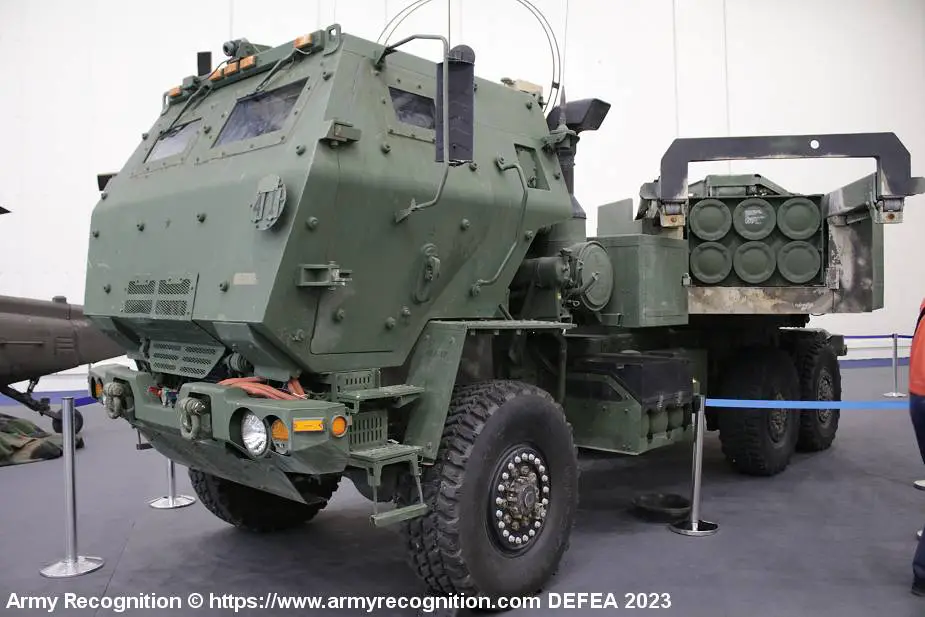
US Army M142 HIMARS MLRS Multiple Launch Rocket/Missile System (Picture source: Army Recognition)
The exhibition prominently featured the M142 HIMARS rocket launchers, a product of Lockheed Martin. These formidable weapon systems have gained significant attention due to their proven effectiveness in Ukrainian combat zones. Interest has further spiked following an announcement by Lockheed Martin and Rheinmetall on their joint venture to develop a similar missile defense system for Germany.
The High Mobility Artillery Rocket System (HIMARS) is an advanced, combat-proven, wheeled rocket artillery system developed by Lockheed Martin for the United States Armed Forces. It is a highly mobile, light, and fast system, capable of firing six rockets or one Army Tactical Missile System (ATACMS) missile from its M142 launcher, which is mounted on a 6x6 FMTV.
The HIMARS has a maximum firing range of approximately 300 kilometers with the ATACMS missile and 70 kilometers with the Guided Multiple Launch Rocket System (GMLRS) rockets. It provides precision strike capabilities and is capable of hitting targets with high accuracy, making it an effective weapon for suppressing and destroying enemy air defenses, artillery, and infantry formations.
DEFEA 2023 also saw the U.S. Army display the legendary UH-60M Black Hawk helicopter, a Sikorsky/Lockheed Martin production. This iconic military aircraft has earned global recognition, serving in 35 countries with over 5,000 units and clocking more than 15 million flight hours, four million of which were in combat scenarios. The Greek Armed Forces have expressed interest in this helicopter model to replace their aging UH-1 Huey and to fulfill Air Force search and rescue roles.
The Sikorsky UH-60 Black Hawk is a versatile, twin-engine, medium-lift utility helicopter that has been a mainstay of the U.S. military since it entered service in 1979. The Black Hawk is designed to perform a wide array of missions, including troop transport, medical evacuation (MEDEVAC), electronic warfare, and special operations.
In troop transport operations, the Black Hawk can carry a squad of 11 fully equipped soldiers in addition to its crew of 3 (pilot, co-pilot, and crew chief). The Black Hawk is also widely used for MEDEVAC operations, with the capability to carry six stretchers along with medical personnel. For electronic warfare and command-and-control missions, the Black Hawk can be equipped with various sensors and communication systems. In special operations, the Black Hawk is often modified for increased range, stealth, and carrying capacity. This variant, known as the MH-60, is used by the U.S. Army's 160th Special Operations Aviation Regiment (SOAR).
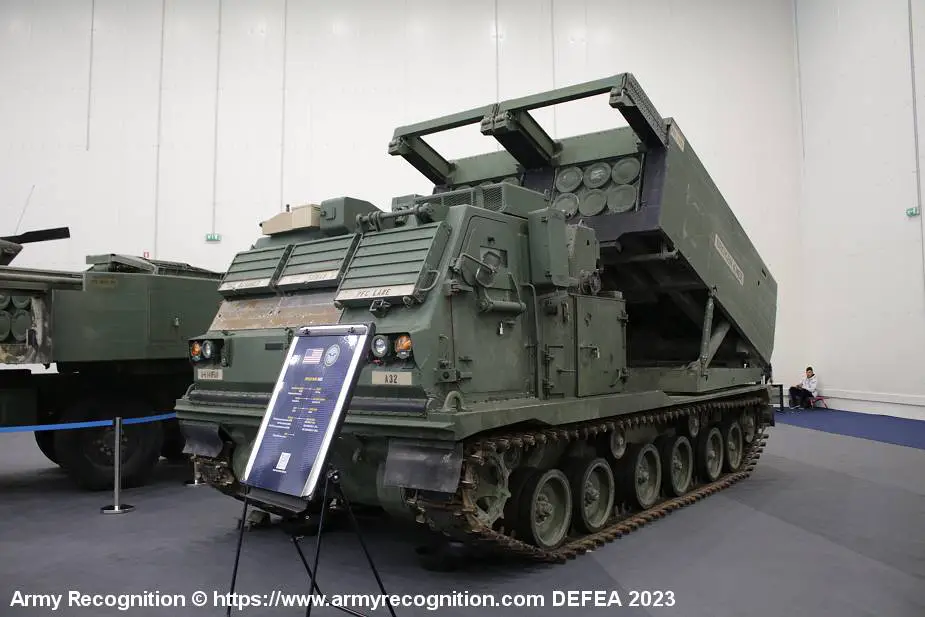
M270 tracked armored MLRS Multiple Launch Rocket/Missile System (Picture source: Army Recognition)
The M270 MLRS (Multiple Launch Rocket System) also made a formidable appearance in its latest A1 version, boasting a new fire control system, a 600 hp engine, an upgraded transmission system, and improved cabin armor. The U.S. Army reportedly plans to upgrade its entire fleet of M270A1 and decommissioned M270 to this superior A2 version.
The M270A1 Multiple Launch Rocket System (MLRS) is an upgraded version of the M270, a self-propelled, armored, multiple rocket launcher utilized by the United States and its allies. Developed by Lockheed Martin, the M270A1 provides highly responsive, all-weather, long-range artillery support to ground forces. The MLRS can engage a variety of targets, from enemy infantry and armored vehicles to air defenses and fortifications, making it highly effective in both conventional and asymmetric warfare scenarios.
The main armament of the M270A1 MLRS consists of two pods, each capable of holding six rockets or one Army Tactical Missile System (ATACMS) missile. The MLRS can fire a variety of munitions, including the M26 rocket, which disperses 644 M77 Dual-Purpose Improved Conventional Munition (DPICM) bomblets for anti-personnel and anti-materiel effects, and the M30 Guided Multiple Launch Rocket System (GMLRS) rocket, which provides precision strike capabilities. The ATACMS missile can engage targets up to 300 kilometers away, while the GMLRS rocket has a range of 70 kilometers, significantly increasing the reach of ground forces. The system also has the ability to fire reduced-range practice rockets (RRPR) for training purposes.
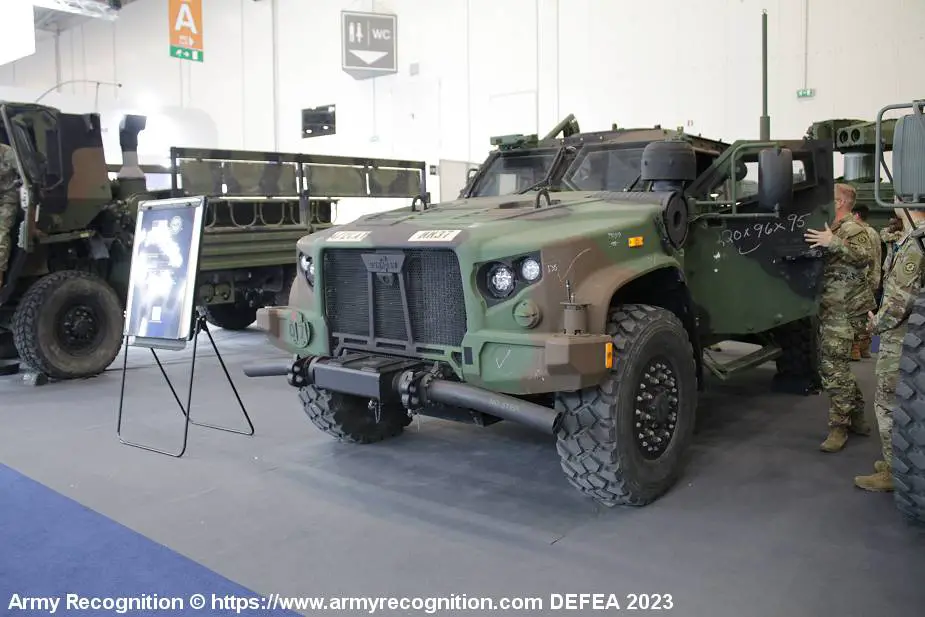
US Army JLTV Joint Light Tactical Vehicle (Picture source: Army Recognition)
Among the other highlights at the U.S. Army's exhibition booth was the Oshkosh JLTV (Joint Light Tactical Vehicle), deployed by the U.S. Army, Marines, and Special Operations Command. This vehicle holds the potential for equipping the Israeli Spike NLOS system, soon to be accessible to the Greek Armed Forces.
The Joint Light Tactical Vehicle (JLTV) is a series of vehicles designed to replace many of the High Mobility Multipurpose Wheeled Vehicles (HMMWVs or Humvees) currently in service with the U.S. military. Developed by Oshkosh Defense, the JLTV program aims to provide a new generation of light military vehicles that deliver unprecedented protection, payload, and performance. The JLTV offers enhanced survivability against improvised explosive devices (IEDs) and ballistic threats, which were key weaknesses of the Humvee in recent conflicts.
The JLTV comes in two main variants: a two-seat utility variant and a four-seat general-purpose variant. The vehicle can be configured for various roles, including troop transport, command and control, reconnaissance, patrol, ambulance, and evacuation. It can be outfitted with a range of light to medium-caliber weapon systems, including remotely operated weapon stations. Its scalable armor design, advanced suspension system, and superior off-road capabilities make the JLTV a significant upgrade over the Humvee in terms of both mobility and protection.
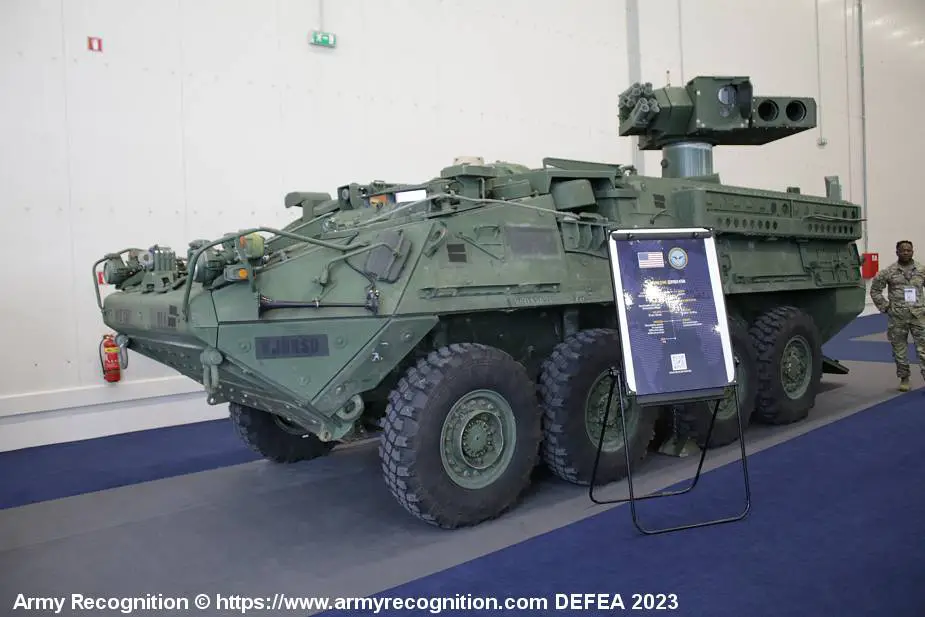
US Army Stryker M1134 Tow anti-tank armored vehicle (Picture source: Army Recognition)
Also showcased was Oshkosh's largest vehicle, the FMTV (Family of Medium Tactical Vehicles), and the M1134 TOW Carrier ATGM (Anti-Tank Guided Missile Vehicle), an anti-tank weapon of the Stryker family with impressive armored threat capabilities.
The Stryker M1134 Anti-Tank Guided Missile Vehicle (ATGM) is one variant of the Stryker series of wheeled armored fighting vehicles developed by General Dynamics Land Systems for the United States Army. It's an integral part of the Stryker Brigade Combat Teams (SBCTs) and serves as their primary anti-armor platform, providing a long-range, direct fire, and precision capability.
The M1134 is equipped with a TOW (Tube-launched, Optically tracked, Wire-guided) missile system that can engage a wide variety of targets, including tanks, other armored vehicles, fortifications, and helicopters. The launcher on the M1134 can elevate and traverse to track targets, and it carries two TOW missiles ready to fire with an additional 10 missiles stowed inside. The TOW missile system can defeat armored vehicles, fortifications, and other targets at distances of up to about 3.75 kilometers. Additionally, the M1134 retains the same 8x8 mobility and survivability features of the Stryker vehicle family, making it a flexible and versatile component of the SBCTs.
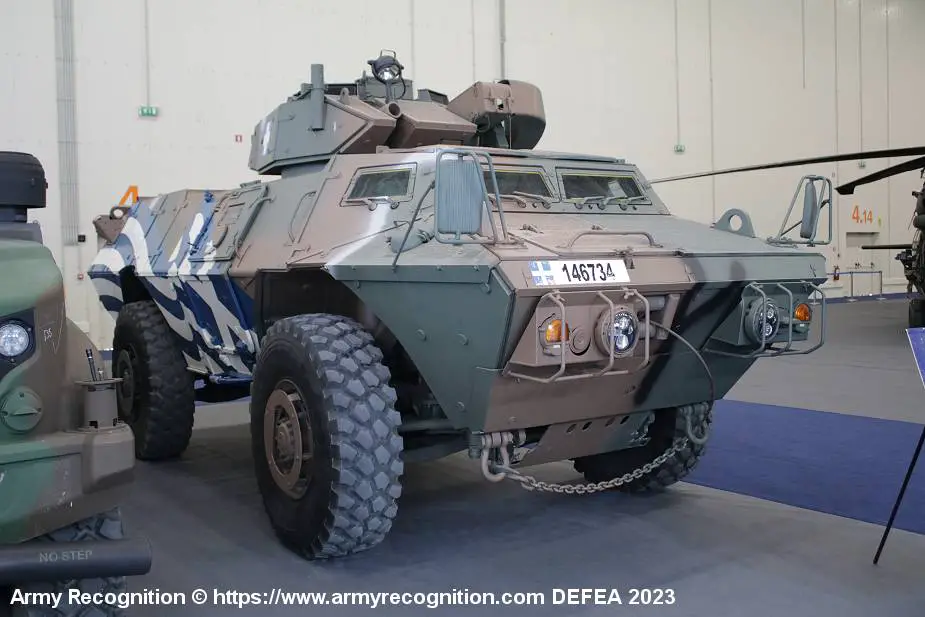
Greek Army American-made M1117 4x4 wheeled armored vehicle (Picture sourc:e Army Recognition)
The Textron M1117 Guardian, a recent addition to the Greek Armed Forces, was also on display. As part of the European Defence Agency program, Athens is slated to receive a total of 1,200 vehicles of this type, with hundreds already delivered and the rest arriving in the coming months.
The M1117 Guardian Armored Security Vehicle (ASV) is a robust, highly mobile, multi-purpose tactical wheeled vehicle developed by Textron Marine & Land Systems primarily for use by the U.S. Army's Military Police Corps. It was designed to provide improved protection for military police engaged in convoy escort, law enforcement, and security operations, particularly in hostile environments. The vehicle is well-armored and resistant to small arms fire, artillery shell fragments, land mines, and IEDs.
The M1117 is equipped with a turret that houses a 40mm MK19 automatic grenade launcher and a .50 caliber M2 machine gun in an Overhead Weapon Station (OWS). This combination provides the Guardian with a substantial amount of firepower for both offensive and defensive operations. Additionally, the vehicle can mount a variety of other weapons and equipment to suit specific mission requirements. The M1117 is highly regarded for its enhanced survivability, firepower, and mobility compared to earlier military police vehicles, and it has proven highly effective in various combat situations, notably during the conflicts in Iraq and Afghanistan.

US Army Javelin FGM-148 man-portable anti-tank missile weapon system (Picture source: Army Recognition)
At DEFEA 2023, soldiers of the US Army also displayed the Javelin FGM-148 man-portable anti-tank weapon system. The Javelin missile has been a real star in Ukraine, reportedly inflicting massive losses on Russian armor, with some sources suggesting a kill rate of around 90%.
The FGM-148 Javelin is a portable, shoulder-fired, anti-tank guided missile system developed by the American companies Raytheon and Lockheed Martin. It is renowned for its "fire-and-forget" capability, which allows the operator to launch the missile and then take cover or reposition, as the missile does not require further guidance after launch. This is a significant tactical advantage as it minimizes the operator's exposure to enemy fire.
The Javelin missile uses an infrared seeker for guidance and carries a tandem-shaped-charge warhead capable of defeating modern main battle tanks, including those equipped with reactive armor. The missile can be fired in either direct attack mode or top attack mode. In direct attack mode, the missile flies directly to the target, which is useful for hitting buildings, helicopters, or lightly armored vehicles. In top attack mode, the missile climbs above and then strikes down on the target, defeating the tank where its armor is weakest. The Javelin's high accuracy, flexibility, and lethal warhead make it a critical asset for infantry units facing armored threats.
The FGM-148 Javelin has a substantial operational range, making it effective for various battlefield engagements. In its original configuration, the Javelin has a range of approximately 2,500 meters. However, an extended-range version of the Javelin, known as the Javelin F-Model, has been developed which increases the missile's maximum range up to around 4,750 meters. This extended range further enhances the Javelin's flexibility on the battlefield, allowing it to engage targets from greater distances and increasing the safety margin for its operators.


























